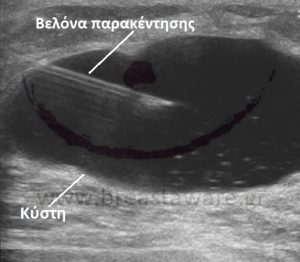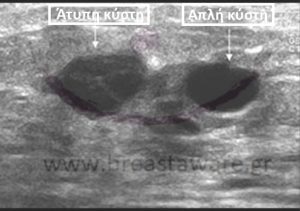Breast Cyst: Everything You Need to Know
What is a breast cyst?
A breast cyst is a round or oval fluid-filled sac that forms due to blockage and dilation of a milk duct. It can appear as single or multiple lumps in the breast and can be felt through self-examination, clinical examination or breast imaging. The size and number of cysts vary, and a sudden increase in size can cause severe, localized pain.
How common are breast cysts?
The Breast cysts are among the most common findings in women, especially between 35 and 50 years old. A large American study found cysts in 37.5% of participants, more frequently in premenopausal than postmenopausal women.

How can I tell if I have a breast cyst?
Simple clinical examination is not enough to determine whether a lesion is benign cyst, benign tumor or malignancy. Breast ultrasound is the main tool to distinguish whether a lesion is fluid-filled, solid or mixed. Based on the ultrasound characteristics, cysts are distinguished into:
- Simple cysts
- Complicated cysts
- Complex or atypical cysts
In some cases, mammography or breast MRI may be needed for more detailed evaluation.
For a definitive diagnosis, it is done fine needle aspiration (FNA), where the fluid from the bladder is aspirated and examined.
Is there a risk of malignancy with breast cysts?
- Simple cysts: No associated cancer risk.
- Complicated cysts: Cancer risk is extremely rare (<1%).
- Complex or atypical cysts: Risk ranges from <1% up to 23%, depending on ultrasound characteristics.
Early diagnosis and proper categorization are key for safe management.

What is the proper management of breast cysts?
- Simple cysts: Usually require no treatment and often resolve spontaneously within 5 years.
- In case of pain or pressure: Fine needle aspiration (FNA) is recommended for relief. If the cyst recurs, a new FNA or, if required repeatedly, surgical removal may be necessary.
- Complicated cysts: Managed with ultrasound follow-up every 6 months or biopsy, depending on clinical picture and patient preference.
- Complex or atypical cysts: Require core needle biopsy or surgical excision, often with placement of a metallic clip for precise localization.
Individualized management based on imaging and clinical findings ensures the best care for each woman.
Stay informed and care for your breast health with BreastAware.gr
At BreastAware.gr , you will find reliable information and up-to-date guidelines on breast prevention, diagnosis, and care. Our mission is to empower every woman with knowledge and confidence about her breast health. Get informed, ask your specialist, and stay Breast Aware! Breast Aware!
Bibliography:
- Al Khalil R, Riker AI. Breast Cyst. Treasure Island (FL): StatPearls Publishing; 2024 Jan.
- Candelaria RP, Harris K, Powell JL. Cystic Breast Disease: Management Guidelines for the Primary Care Physician. J Am Board Fam Med. 2015 Sep-Oct;28(5):652-9.
- Berg WA, Campassi C, Ioffe OB. Cystic breast masses and the risk of malignancy: sonographic-pathologic correlation. AJR Am J Roentgenol. 2003 Apr;180(4):1225-30.
- Jackson VP. The role of US in breast imaging. Radiology. 1995 Jan;196(1):1-10.
- Sickles EA, D’Orsi CJ, Bassett LW, et al. ACR BI-RADS® Atlas, Breast Imaging Reporting and Data System. American College of Radiology; 2013.
